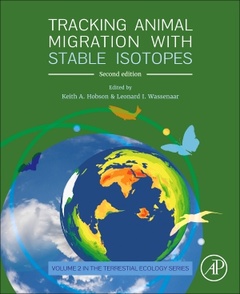Tracking Animal Migration with Stable Isotopes (2nd Ed.)
Coordonnateurs : Hobson Keith A., Wassenaar Leonard I.

Tracking Animal Migration with Stable Isotopes, Second Edition, provides a complete introduction to new and powerful isotopic tools and applications that track animal migration, reviewing where isotope tracers fit in the modern toolbox of tracking methods. The book provides background information on a broad range of migration scenarios in terrestrial and aquatic systems and summarizes the most cutting-edge developments in the field that are revolutionizing the way migrant individuals and populations are assigned to their true origins. It allows undergraduates, graduate students and non-specialist scientists to adopt and apply isotopes to migration research, and also serves as a useful reference for scientists.
The new edition thoroughly updates the information available to the reader on current applications of this technique and provides new tools for the isotopic assignment of individuals to origins, including geostatistical multi-isotope approaches and the ways in which researchers can combine isotopes with routine data in a Bayesian framework to provide best estimates of animal origins. Four new chapters include contributions on applications to the movements of terrestrial mammals, with particular emphasis on how aspects of animal physiology can influence stable isotope values.
1. Why study animal Movements? 2. An Introduction to the Light Stable Isotopes for use in Terrestrial Animal Migration Studies 3. Isoscapes: the basis for inferring animal origins and movements using stable isotopes 4. Applying Isotopic Methods to Tracking animal Movements 5. Tracking Bats and other Terrestrial mammals: Considerations of Physiology 6. Isotopic Tracking of Marine and Aquatic Animals 7. Applying Compound-Specific Methods: The Next frontier in Isotopic Tracking of Animals 8. Analysis and design for Isotope based Studies of Migratory Animals 9. Tools for the User: Assigning Animals to Origins using Mixed Models in R: the IsoriX package 10. Future Directions and Challenges for Using Stable Isotopes in Advancing Animal Migration research
Graduate students, university, government and NGO researchers engaged in theoretical and practical applied animal ecology and conservation. Wildlife managers tasked with the conservation of migratory species. Academics engaged in research on animal migration and movements. Graduate students could use this book as a text for a graduate-level course in applications of stable isotopes to animal ecology and migration.
Dr. Len Wassenaar was a senior Research Scientist with Environment Canada for 23 years, specializing isotope analytical measurements and applications in hydrology and ecology. He and Dr. Hobson worked closely together to develop many of the foundational analytical tools to assign animals to origins using isotope approaches. Currently, Dr. Wassenaar serves as a Team Leader in Nuclear Applications Division of the International Atomic Energy Agency (IAEA) in Vienna, Austria.
- Includes an animal physiology component that is an in-depth overview of the cautions and caveats related to this technique
- Covers marine and aquatic isoscapes and methods to track marine organisms for researchers trying to apply isotopic tracking to animals in these environments
- Features state-of-the-art statistical treatments for assignment and combining diverse datasets
Date de parution : 09-2018
Ouvrage de 268 p.
19x23.3 cm
Thèmes de Tracking Animal Migration with Stable Isotopes :
Mots-clés :
Amino acid analysis; Amino acid bio chemistry; Animal conservation; Animals of unknown origin; Assignment model types; Breeding; Carbon isotopes; Compound specific isotope analyses; Compound specific isotope analysis; Computer modeling and simulation; Conservation; Consumer physiology; Data analysis; Direct isotope tracers; Extrinsic markers; Fishery management; Foraging ecology; Global-spatial isotopes; H isoscape; Hydrogen and oxygen isotopes; Intrinsic markers; IsoriX; Isoscape data products; Isoscapes; Isotope calibration model; Isotope discrimination; Isotope patterning; Isotope tracking; Isotope-based studies; Isotopic heterogeneity; Isotopic principles; Isotopic retention in tissues; Isotopic sampling; Isotopic variation; Isotopic variations; Local-spatial isotopes; Mapping isotopes; Marine isoscapes; Marine migration; Migration; Migratory bat case study; Migratory connectivity; Migratory systems; Nitrogen isotopes; Open source software; R-environment; Reference organisms; Sample collection methods; Sampling considerations; Spatial markers; Stable isotope analyses; Stable isotopes; Terrestrial mammals; Transfer functions



